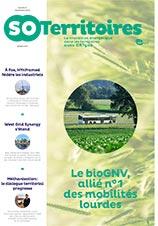Heavy vehicles in the regions

While discussions on the EU’s future “CO2 Regulation” for heavy vehicles continue, a weight of opinion attests to the benefits of bioNGV – a renewable version of natural gas for vehicles (NGV) – as a way to decarbonise the sector alongside electricity, hydrogen and biofuels.
“Several studies, in particular Carbone 4 or IFPEN*, show that bioNGV is as effective as electricity or hydrogen in reducing vehicle CO2 emissions, if we stop thinking only in terms of exhaust.”Jean Terrier
Mobility Manager at GRTgaz
On 14 February 2023, the European Commission published its draft revision of the “CO2 Regulation” for heavy vehicles, which proposes the gradual phasing out of combustion engine vehicles, regardless of whether they run on renewable fuels such as bioNGV. As things stand, however, local authorities are confirming their interest in bioNGV. It is even proving to be the best immediately available solution to existing challenges.
“We cannot waste any more time in speeding up the decarbonisation of transport – the only sector in Europe whose GHG emissions have not decreased in 30 years,” says Jean Terrier, Mobility Manager at GRTgaz. “There is a high risk that electric and hydrogen solutions will not be ready for heavy vehicles in the short term. And even in the long term, these may not be able to meet all of the sector’s needs. We strongly believe that the basis for decarbonising the industry is an energy mix that incorporates all efficient alternatives to diesel, including bioNGV.”
“BioNGV represents a great opportunity in terms of energy independence and the circular economy – important elements that should be factored into the current situation.”Jean Terrier
Mobility Manager at GRTgaz
100% organic NGV mobility before 2033
BioNGV’s positive momentum is something in its favour. Over one year, the portion of bioNGV in delivered NGV has almost doubled from 13% to 25.9% at the end of 2022. At the same time, the country has more than 300 public refuelling points, with more and more calls for tender from mobility authorities or freight forwarders requiring 100% bioNGV. According to the French Association of Natural Gas Vehicles (AFGNV), heavy mobility with 100% organic NGV is achievable before 2033. The renewable gas sector has stated that production will remain sufficient to cover these needs and other uses (industry, buildings, etc.). And what about operating costs? After the surge in gas prices in 2022, the price of bioNGV is falling. As Jean Terrier states: “We must bear in mind that energy price increases are a reality, both now and in the future – electricity and hydrogen included.” Says Jean Terrier.
Circular solutions and their benefits
A heavy mobility energy mix that includes bioNGV, both in the short term and as a sustainable, long-term option alongside biofuels, electricity and hydrogen, seems like a strong solution. This vision is currently shared by many local authorities and industry stakeholders (see opposite). BioNGV meets transport needs, is competitively priced, reduces CO2 emissions and improves air quality, with less than 95% fine particles emitted and up to 70% less nitrogen oxides compared to the diesel equivalent. It also bolsters the region’s circular economy, with local biomethane production able to supply refuelling stations, offering the chance of unprecedented energy autonomy both for the regions and for France.
The proposed decarbonisation of heavy mobility
In its proposed revision of the “CO2 Regulation” for heavy vehicles, the European Commission’s plans to decarbonise mobility are based solely on a combination of electricity and hydrogen for new vehicles, for buses purchased after 2030, and, with some rare exceptions, for HGVs and coaches purchased after 2040. The fact that only CO2 exhaust emissions are considered, and not the complete life cycle, penalises bioNGV. But its positive features are nevertheless known: produced locally, it reduces a vehicle's CO2 emissions by 80% compared to diesel. There is also a paradox when we consider that the RED II* European directive acknowledges bioNGV to be an effective decarbonisation vector.
* Directive (EU) 2018/2001 of 11 December 2018 on promoting the use of energy produced from renewable sources – the so-called “RED II” directive – sets the criteria for the sustainability of bioenergies, including biogas.
Publications


